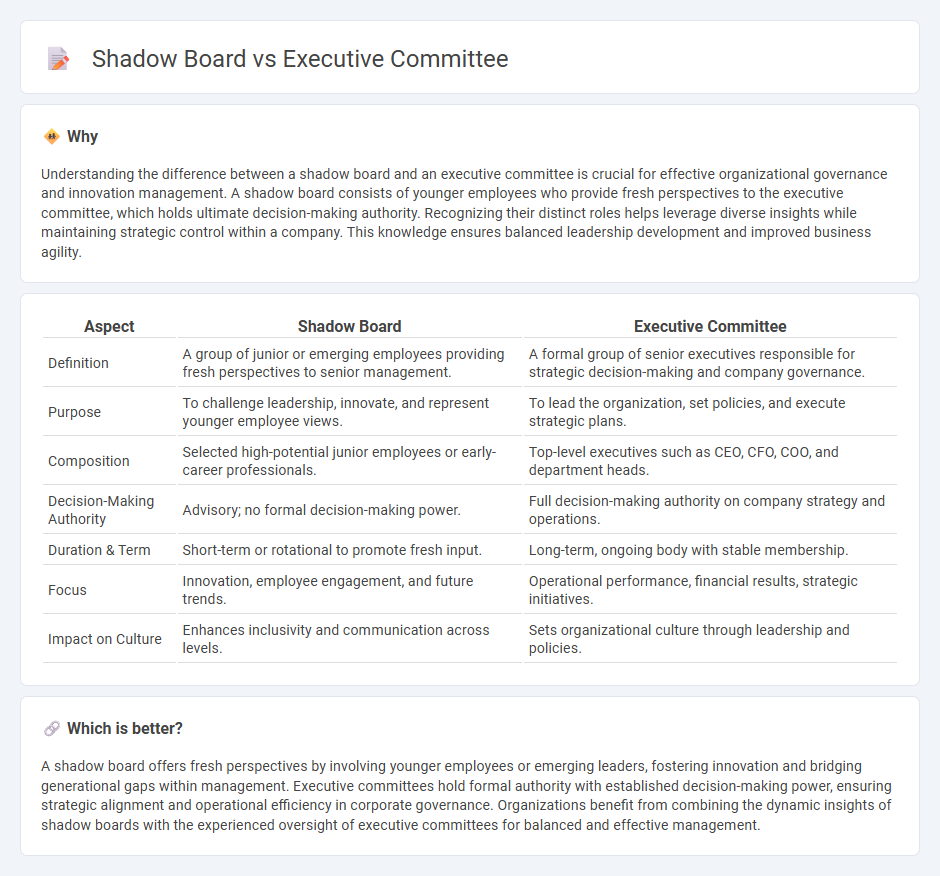
Shadow boards consist of emerging leaders who provide fresh perspectives to influence organizational decisions, promoting innovation and agility within management structures. Executive committees are senior leadership groups responsible for strategic direction, policy-making, and overall company governance. Explore the distinct roles and advantages of shadow boards versus executive committees to enhance your leadership strategy.
Why it is important
Understanding the difference between a shadow board and an executive committee is crucial for effective organizational governance and innovation management. A shadow board consists of younger employees who provide fresh perspectives to the executive committee, which holds ultimate decision-making authority. Recognizing their distinct roles helps leverage diverse insights while maintaining strategic control within a company. This knowledge ensures balanced leadership development and improved business agility.
Comparison Table
| Aspect | Shadow Board | Executive Committee |
|---|---|---|
| Definition | A group of junior or emerging employees providing fresh perspectives to senior management. | A formal group of senior executives responsible for strategic decision-making and company governance. |
| Purpose | To challenge leadership, innovate, and represent younger employee views. | To lead the organization, set policies, and execute strategic plans. |
| Composition | Selected high-potential junior employees or early-career professionals. | Top-level executives such as CEO, CFO, COO, and department heads. |
| Decision-Making Authority | Advisory; no formal decision-making power. | Full decision-making authority on company strategy and operations. |
| Duration & Term | Short-term or rotational to promote fresh input. | Long-term, ongoing body with stable membership. |
| Focus | Innovation, employee engagement, and future trends. | Operational performance, financial results, strategic initiatives. |
| Impact on Culture | Enhances inclusivity and communication across levels. | Sets organizational culture through leadership and policies. |
Which is better?
A shadow board offers fresh perspectives by involving younger employees or emerging leaders, fostering innovation and bridging generational gaps within management. Executive committees hold formal authority with established decision-making power, ensuring strategic alignment and operational efficiency in corporate governance. Organizations benefit from combining the dynamic insights of shadow boards with the experienced oversight of executive committees for balanced and effective management.
Connection
Shadow boards provide emerging leaders with strategic insights and innovative perspectives that influence the Executive Committee's decision-making process. The Executive Committee leverages these inputs to align corporate governance with evolving market trends and internal talent development. This collaborative relationship enhances organizational agility and fosters leadership succession planning.
Key Terms
Decision-making authority
The executive committee holds formal decision-making authority, responsible for implementing strategies and managing organizational operations. In contrast, a shadow board functions as an advisory group, often comprising younger or future leaders, providing insights without direct decision power. Explore the distinct roles and impact of these governance structures in organizational leadership.
Organizational influence
The executive committee holds formal authority and decision-making power, directly shaping organizational strategy and operations. Shadow boards, composed of emerging leaders or external advisors, influence organizational culture and innovation by providing alternative perspectives without formal authority. Discover how these distinct governance bodies impact organizational influence and decision-making dynamics.
Strategic innovation
Executive committees are formal decision-making bodies responsible for guiding an organization's strategic innovation by approving and overseeing key initiatives. Shadow boards consist of emerging leaders who provide fresh perspectives and innovative ideas to challenge traditional strategies and drive creative solutions. Explore how integrating both structures can enhance strategic innovation within your organization.
Source and External Links
Executive Committee - Roles + Responsibilities - An executive committee helps the board accomplish its work efficiently by facilitating decision-making and acting on behalf of the full board when necessary.
Executive Committee - Interpol - The Interpol Executive Committee supervises the execution of General Assembly decisions and oversees the General Secretariat's administration.
What is the role of the executive committee? - An executive committee is a smaller group of directors appointed to act on behalf of the board, typically consisting of key officers like the chair, vice-chair, secretary, and treasurer.
 dowidth.com
dowidth.com